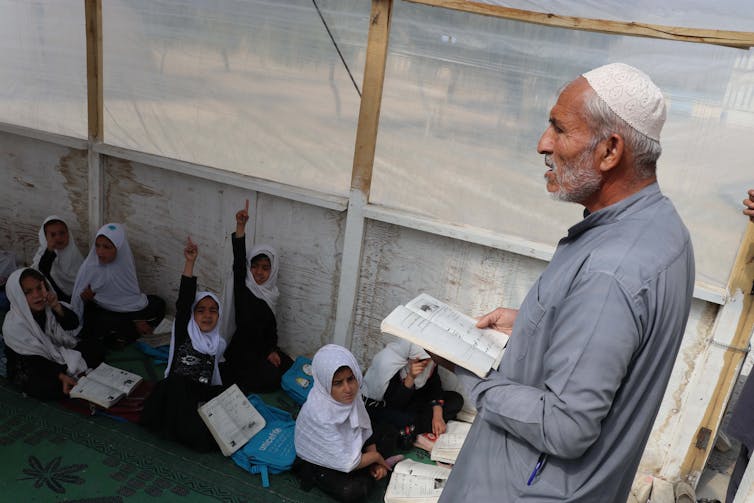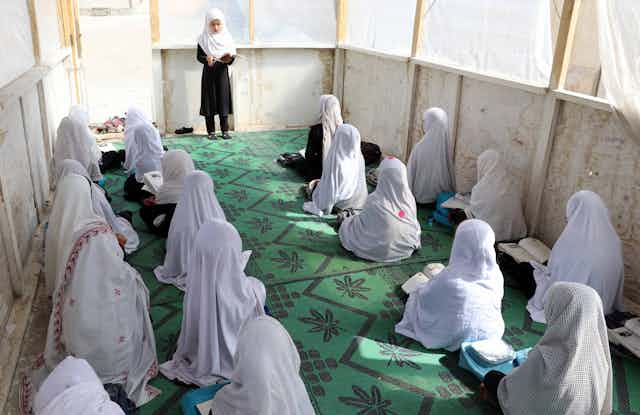Afghan children and teenagers have not had much to look forward to since the Taliban took power in August last year. They have endured six months of uncertainty, anxiety and fear as they waited to see what Taliban rule would bring for them.
Women could not help but dread the return of draconian measures and the trampling of rights they had witnessed 20 years earlier. In the past week those nagging doubts appear to have been validated.
A glimmer of hope had appeared for some when the date for reopening secondary girls’ schools was set for March 23. But this optimism was quashed when girls were turned back from schools. The dashing of so many young hopes caused emotional scenes outside schools, which were widely shared across social media and news outlets as proof that the Taliban had not really changed.
But this is a battle of priorities. Much has been written about the disagreements within the Taliban between religious hardliners based in Kandahar and the more pragmatic contingent, usually military commanders hailing from other provinces. This latest decision on girls’ education is seen as a victory for hardline elements pushing their conservative agenda. But it is worth addressing some of the assumptions in this story from analysts and commentators.
Secondary education for girls – whose priority?
The first assumption is that girls’ secondary education is as important for most Afghans as it is for the international community. The issue of girls’ education has become a rallying point for those, especially women, who wanted to emphasise progress after the fall of the Taliban in 2001.
For many of those who oppose the Taliban, especially those who left the country after August 2021, it’s emblematic of what they see as the oppressive ideology of the Taliban. But there’s more to it than that.
Girls’ education has taken up an extraordinary amount of global media attention since the Taliban prevented girls attending school in the 1990s – part of a raft of repressive measures which also included a temporary ban on women working or leaving home without a male chaperone. In addition, women were banned from being involved in politics or speaking publicly, as they had been under the previous Mujahideen regime.
It was expected that after the Taliban’s first period of power ended in 2001 there would be a massive surge of girls going to school and women flocking to become teachers. But after billions of dollars of investment and much trumpeting on gains, the figures tell a puzzling story.
Education statistics in Afghanistan are notoriously unreliable. But all reports agree that girls have historically lagged far behind boys in access to education. There is evidence this was beginning to gradually shift but despite the strong desire of many Afghan women and girls to access education the figures do not reflect a mad rush by Afghan society to provide it.

In a 20-year review released in 2021, UNESCO stated that: “The number of girls in higher education increased from around 5,000 in 2001 to around 90,000 in 2018.” Some 16% of schools took girls only – but there was a lack of women to teach in them, especially in rural areas, and many families wanted their girls to study with female teachers. In 2018, only 36% of secondary school teachers were female and these tended to be concentrated in urban areas.
School drop-out rates for girls were also high (62% in girls between 13 and 15) as a result of conservative attitudes in the population at large and a range of other issues. Additionally, sexual harassment – of boys and girls – by teachers, social workers and other students, has been an enduring and serious problem. COVID-19 put a further strain both on people’s budgets and the struggling education sector as a whole.
Economic disaster – struggling to survive
Since the Taliban took control, there have been forecasts of the imminent collapse of the Afghan economy, with more than 90% of the population driven to poverty and starvation. The financial collapse was brought on in part by the actions of the international community, which froze Afghanistan’s overseas assets and halted development assistance, among other sanctions. It came against a backdrop of an already struggling economy and the worst drought in living memory.
Many families now face acute food shortages and no prospects for work. It is unclear, therefore, what percentage of families, especially low-income families and those in rural areas, would have been able to send their daughters to school regardless of the Taliban’s actions. They will be those families who can actually access girls’ high schools and those who can afford to do so in the current harsh economic climate.
Taliban thinking
The second assumption is that the Taliban are constantly waiting for an opportunity to make life difficult for Afghan women and girls. This was certainly the case during their first period in power. The Taliban remain deeply conservative and consider themselves the guardians of morality whose brand emphasises anti-corruption.
The minister of higher education – part of an all-male government – has stated publicly that Islam is more important than qualifications so for some, education is of no value to boys or girls. Secular education is certainly not viewed as a human right.
The Taliban have also expressed concern around morality: men teaching female students, as well as girls’ dress code and keeping students segregated in university. But they have allowed primary and tertiary level female students to return to educational establishments with segregation and modifications to buildings and dress.

Is the March 22 turnaround yet another outcome of a face-off between conservative and pragmatic elements within the Taliban movement? Here, it may be useful to address a third assumption: that the Taliban operate in an archaic, internationally isolated bubble of religiosity and keeping girls’ secondary schools closed is in line with its oppressive attitude towards women in general. With no female secondary school pupils there will soon be no young women to take up their places at university.
But it’s important to remember that the Taliban have survived the past two decades by negotiating and making deals. And they understand, based on numerous media campaigns and social media commentary over the past two decades, that improving girls’ education in Afghanistan is a priority for the international community.
It is not impossible to imagine that, having seen the UK pay a longstanding debt to Iran based on the pressure of wanting to secure the release of Briton Nazanin-Zaghari Radcliffe, the Taliban may link a gradual easing of restrictions on female education with concessions from the international community around financial sanctions.
Thus far, keeping girls’ secondary schools closed appears to have had the opposite effect as Washington has rowed back on plans to progress to US diplomatic representation for the Taliban government. One suspects these are all moves and stratagems on a bigger chessboard.

